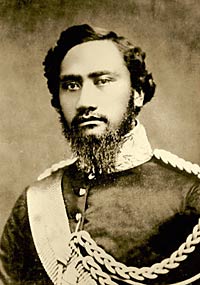| United States | England | Scotland | Ireland | Wales | Canada | World |
| |
The Book of Common Prayer | ||||||
|
|
Hawaiian is a Polynesian language closely related to Tahitian, Maori, etc., and is, as the name implies, spoken primarily in the U. S. state of Hawaii. It is an official language of Hawaii, and, according to the US Census, is today spoken by over 25,000 people. Anglican presence in the Hawaiian Islands essentially started in 1861, when King Kamehameha IV invited the Church of England to send missionaries. Accordingly, Thomas Staley was consecrated bishop in London and sent to Honolulu in 1862. Prior to this, the islands did have a long missionary presence, primarily from American Congregationalists and French Catholics, and most of the native Hawaiians had been converted to Christianity. The King himself had been educated by Congregationalist missionaries, but, after a trip to Britain, became more enamored of the Anglican Church. It may be assumed that missionary activity by the three nations (Britain, France and the U. S.) was often closely tied to attempts to gain political influence in the country. The Anglican Church in Hawaii remained under control of the Church of England until the annexation of the Hawaiian Islands by the United States in 1898. The Church was then transferred to the jurisdiction of the U. S. Episcopal Church in 1902, and has remained so ever since. The Book of Common Prayer presented here was the first in the Hawaiian language, and appears to be a "straight" translation of the 1662 BCP of the Church of England - that is, little or nothing is left out of the services and nothing is added. It appears as 50:1 in David Griffiths' Bibliography of the Book of Common Prayer. This Book is unique in that it was translated by the king, Kamehameha IV, who, from all accounts, was an enthusiastic member of the Church. Today, King Kamehameha IV and his wife, Queen Emma, are commemorated in the Episcopal Church. Further information on the history of the Anglican / Episcopal Church in Hawaii may be found courtesy of Project Canterbury.
|
|
| Thanks are due to Richard Mammana, who transcribed the text. | |
KA
BUKE
PULE ANA A ME KA HOOKO ANA KAUOHA HEMOLELE E LIKE ME KA MEA I KAUOHAIA NO
KA HAIPULE ANA MA KA PAE AINA HAWAII. A HUIIA HOI ME NA HALELU A DAVIDA, I HOOKAAWALEA I MEA E HIMEI AI
A HELUHELU AI HALEPULE.
HONOLULU: |
|
| OLELO KAUOHA
NO KA PULE KAKAHIAKA Morning Prayer 5-22 OLELO KAUOHA NO KA PULE AHIAHI Evening Prayer 23-36 KA LITANIA The Litany 37-46 NA PULE A ME NA MANAWALEA ANA NO NA MANAWA A PAU. Prayers & Thanksgivings NA KOLETE, EPISETOLE A ME NA EUANELIO E HELUHELU IA AI I KA HAAWI ANA AKU O KA AHAAINA A KA HAKU NO NA LA A PAU O KA MAKAHIKI. Collects, Epistles & Gospels KE KAUOHA O KA HAAWI IA ANA AKU O KA AHA-AINA A KA HAKU. Holy Communion NA HIMENI A DAVIDA. Psalms of David Preface (written by King Kamehameha) 391-397 |
 King
Kamehameha IV King
Kamehameha IV |
| Web author: Charles Wohlers | U. S. • England • Scotland • Ireland • Wales • Canada • World |